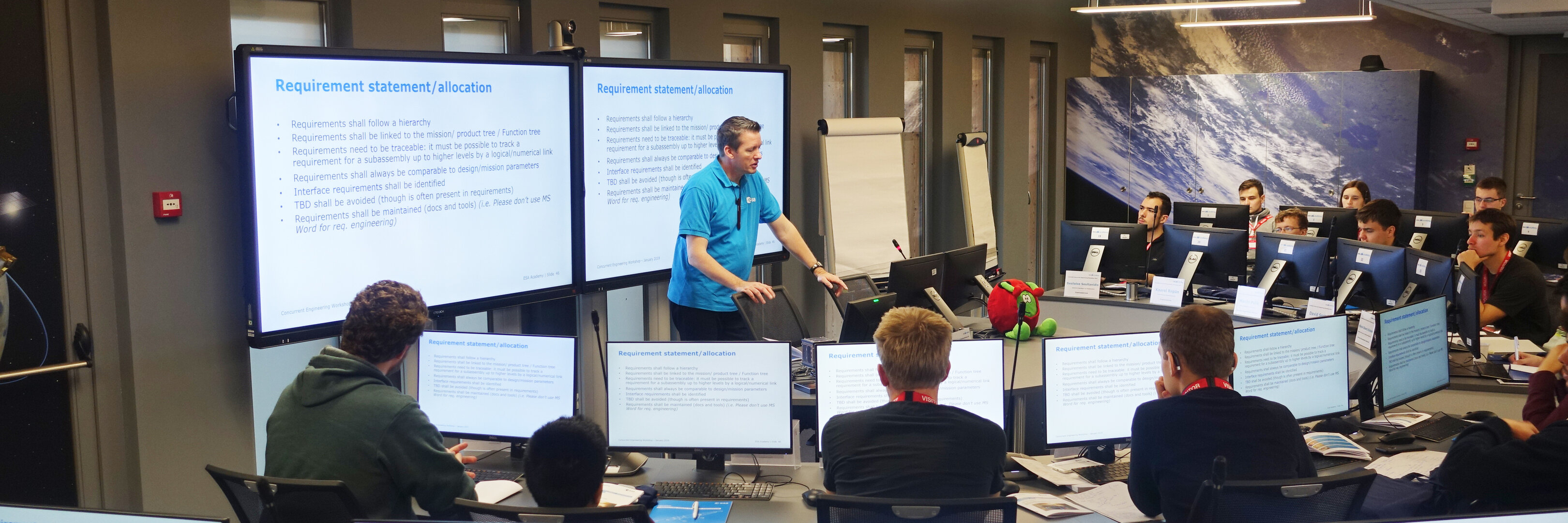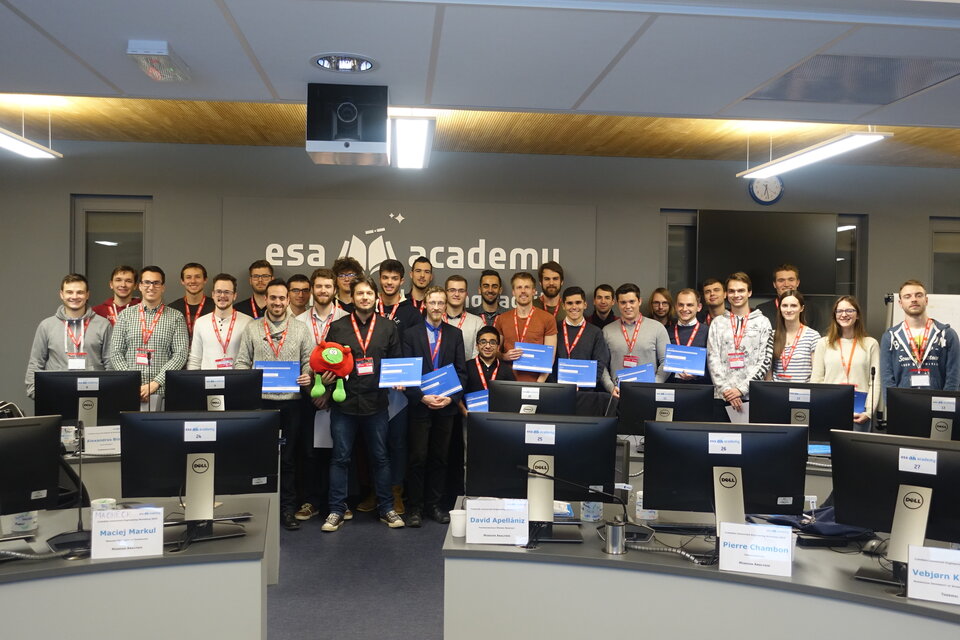From ideas to satellite concepts with ESA Academy
Dreaming of flying a satellite into space but not sure how? Wonder no more! The ESA Education Office and ESA’s Systems and Concurrent Engineering Section are looking for university students to participate in the third edition of ESA Academy’s Concurrent Engineering Workshop dedicated to CubeSats. The 4-day Workshop will be organised between 16 and 19 March 2020 at the ESA Academy’s Training and Learning Facility in ESEC-Galaxia, Belgium.
In concurrent design, all stages of a satellite design take place simultaneously, through the direct collaboration of engineers and scientists from different disciplines in a dedicated and specially equipped facility. This leads to quicker, more efficient designs of space missions, but it has its own set of challenges. Solutions in one area that could impact the design in another must be identified and communicated instantly. ESA’s main Concurrent Design Facility (CDF) is located at ESA’s ESTEC centre in the Netherlands. In collaboration with the engineers running it, ESA Education Office has developed a similar CDF for educational purposes at ESEC-Galaxia, as part of the ESA Academy programme.

The “CubeSats Concurrent Engineering Workshop” introduces student teams to the concurrent design of a CubeSat mission. The Workshop can help to better prepare those universities that are planning to embark on a CubeSat project or are at the early stages of one. Teams wishing to participate do not need to be at an advanced stage in their CubeSat project. They can be at a conceptual and/or preliminary phase of their CubeSat design. During the Workshop they will get the opportunity to present their CubeSat project to the other students and experts. Complementary lectures will also be offered to become acquainted with ESA’s Fly Your Satellite! (FYS) programme as well as ESA good practices. Participation in this Workshop may therefore be an excellent starting point for a possible future application to the FYS programme.
The Workshop

Workshop participants will be divided into groups of students and will be assigned to one of the following disciplines:
- systems engineering,
- trajectory analysis,
- configuration & structures,
- power,
- communications & data handling,
- attitude and orbit control system (AOCS),
- thermal.
Students will then be given CubeSat mission requirements and constraints. Guided by ESA system engineers, they will use the Concurrent Engineering approach and tools to perform a system ‘flow down’, which takes the mission requirements and translates them into system and subsystem requirements. Several possible solutions will arise from this analysis, and the students will compare these to understand the trade-offs of each design solution. Eventually, after several concurrent engineering iterations, the students will come to a final concept design that they will present and defend, discipline per discipline, to ESA experts.
Preliminary schedule
| Day 1 |
Introduction to Concurrent Engineering and Requirements Management Get familiar with Workbooks and Open Concurrent Design Tool (OCDT) Introduction to the Mission Student team CubeSat projects presentations CubeSat Architectures |
| Day 2 |
First Concurrent Engineering iteration Introduction to ESA, ESA Education and the Fly Your Satellite! Programme |
| Day 3 |
Finalisation of the first Concurrent Engineering iteration ESA TEC CubeSats Visit of ESEC-Redu How to increase CubeSat reliability Second Concurrent Engineering iteration |
| Day 4 |
Finalisation of the second Concurrent Engineering iteration Final Presentations |
Who can apply?
Preferred teams are those that are considering to start, or have recently started a university CubeSat project, and/or those teams interested in applying Concurrent Engineering methodologies to their CubeSat design.
CubeSat teams must comply with the following requirements:
- the CubeSat team must be from a University based in an ESA Member State, Canada or Slovenia;
- at least 4 university students are participating in the project;
- the project is educational.
All team members willing to participate in the Workshop must fulfil the following eligibility criteria:
- be aged between 18 and 32 at the time of application;
- be a citizen of an ESA Member State, Canada or Slovenia;
- be enrolled as a full-time 3rd / 4th year Bachelor, Master or PhD student at a university of an ESA Member State, Canada or Slovenia at the time of the Workshop;
- be studying an engineering subject or physics.
ESA will cover the cost of accommodation and meals as well as up to 200 euros for travelling to Belgium, for each selected student.
How to apply
An overview of the CubeSat project shall be submitted by the team leader (e.g. university professor or academic leading the team). Students within each team shall submit their individual application as well.
Note that only a limited number of students from each team will be invited to attend the Workshop. For student selection within each team, several factors will be taken into consideration, such as the overall balance of disciplines during the concurrent engineering work and the educational return for the team. Team members are not allowed to apply via multiple teams and only one proposal per university faculty or department can be considered.
Team leader only:
- Download the CubeSat Project Overview Template and fill it out;
- Send it to tlp @ esa.int (PDF, maximum 8 pages). The subject of the email and the file name should be in the format ‘CCEW2020 – CubeSat Project Overview – (Name of the team)’;
All team members:
- Fill in the online application form;
- Provide CubeSat team name;
- Select preferred disciplines;
- Upload a motivation letter (PDF, maximum 1 page, no images);
- Upload a CV (Europass format, PDF, maximum 2 pages, no images);
- Upload a formal recommendation letter (PDF, maximum 1 page, including signature, no images) from a university professor or academic supervisor from the applicant’s current university;
- Upload an official copy of academic records (PDF, in English, with the university stamp).
All answers and documents should be in English (except academic records if not available).
The deadline for applications is 9 February 2020 23:59 CET.
For more information, please contact tlp @ esa.int



